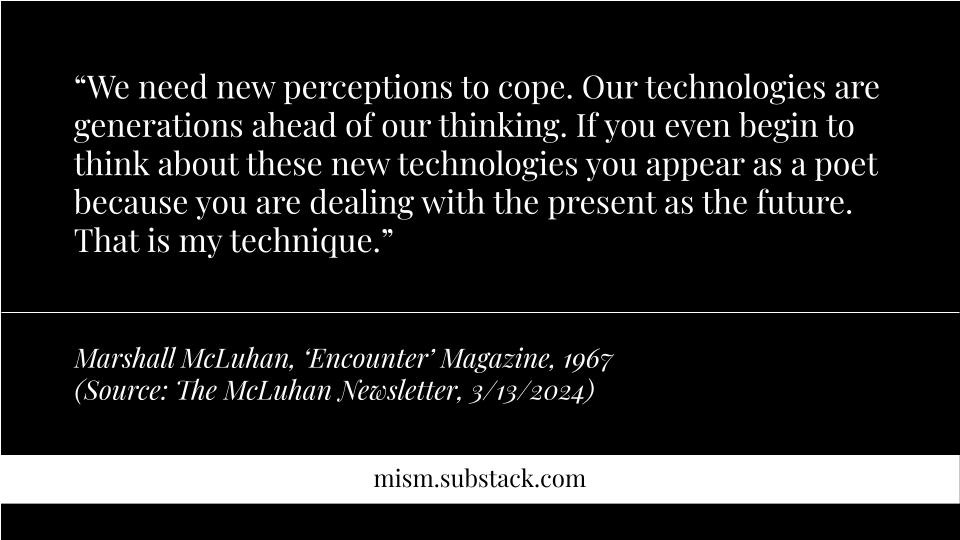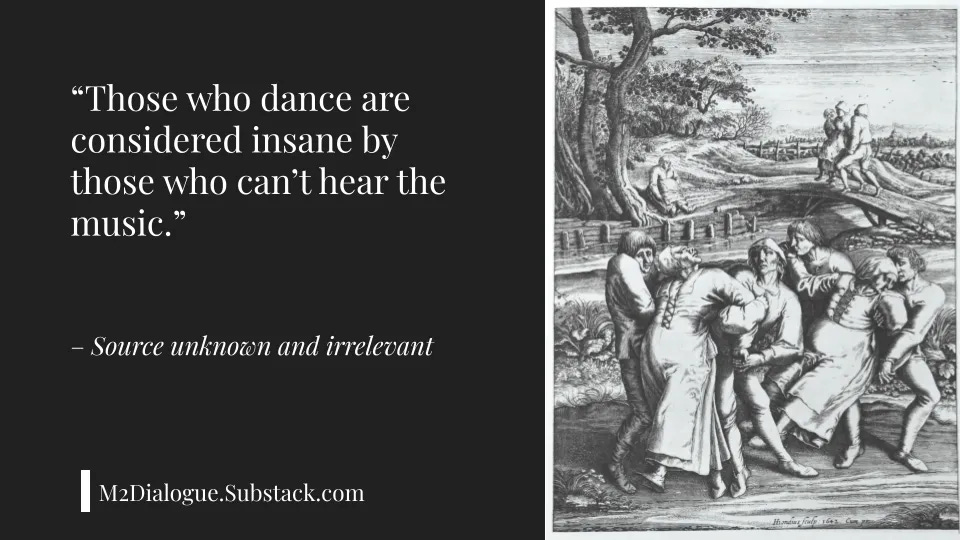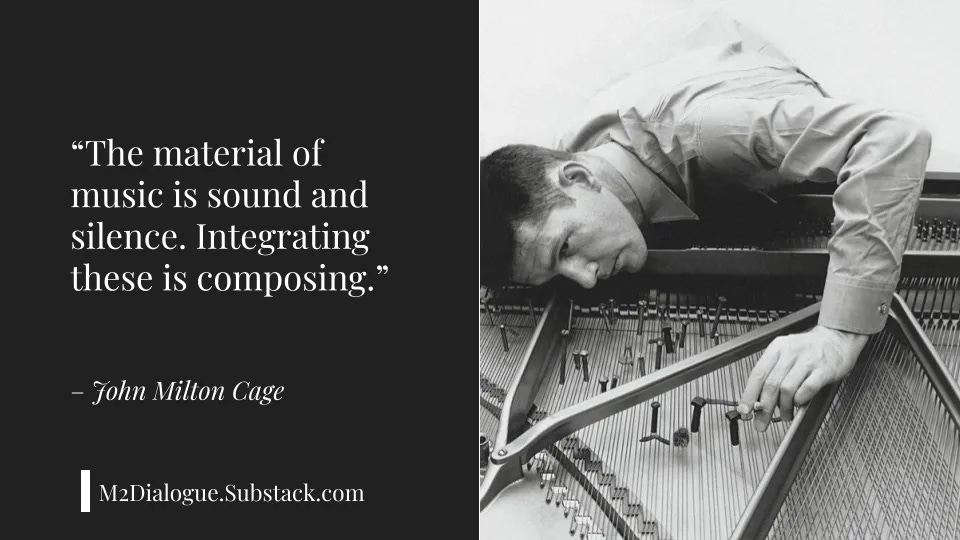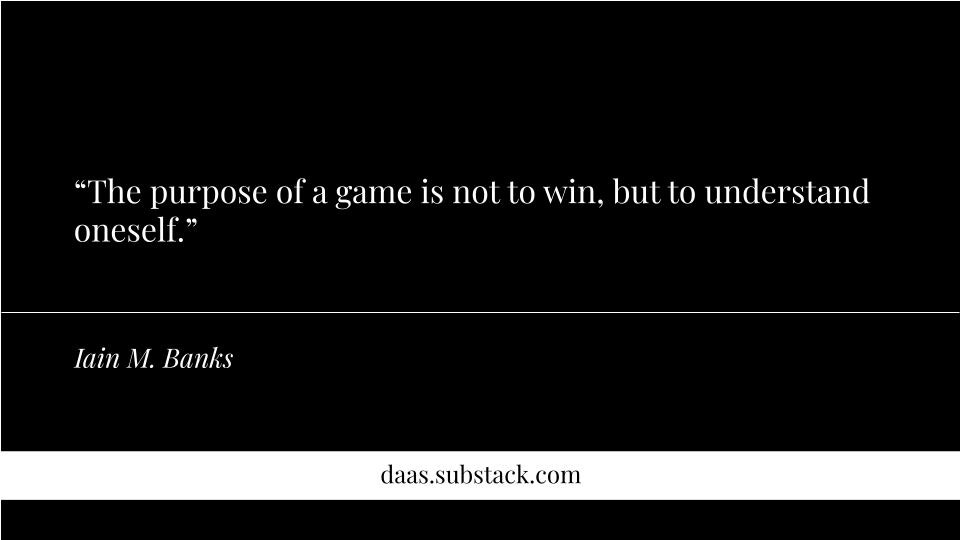For reasons I broadly describe as technical, I haven’t yet returned to passage-by-passage readings of Marshall McLuhan’s Understanding Media: The Extensions of Man. As I mentioned in my Reintroduction, when I do return to the chapter readings, I’d like to skip ahead from Chapter 4 — The Gadget Lover: Narcissus as Narcosis — to Chapter 14 — Money: The Poor Man's Credit Card.
While the technical difficulties persist and my readings of this seminal text remain on hold, I offer you readings of our world that have energized my own work. I also included here a few updates about the state of my media and The New Game: Ask DaaS - Dialogue as a Service.
Annotations
I begin with six annotated sources that connect the history of technology to the art of living, our view of the future, the origin of all conflict, and the rediscovery of silence in our noisy media ecology.
1. The Medium in View
To think and write about technology and culture is just to think and write about how to be human in the world today.
The art of living, like any other art, is the art of learning to work creatively within the constraints of the medium.
Thinking in terms of an art of living also invites me to consider how I might need to change in order to practice it well. It suggests not a set of methods which demand nothing of me, but a set of practices or skills which I must cultivate and whose cultivation changes me in the process.
We are formed by the structures of modern society to be insatiable consumers of an increasing range of commodified things and experiences and services. There is no art in this, because the tacit assumption that we must buy into along the way is that there is no limit to what we can consume.
But if the constraints of a medium of art appear self-evident—the canvas is only so large, the instrument plays only a certain range of notes—what are the limits of the medium on which the art of life plays. Indeed, what exactly is the medium in view?
“The medium on which the art of life plays” is an arresting phrase. I certainly can't say what exactly this medium is, but I may have been gazing in its direction when I wrote these lines: “I'm not a bird trapped in a cage / But a dancer in the acoustic age.”
2. Vigilant Nonreductionism
Desire, Dopamine, and the Internet by
The dopamine framing at once tells us too little and also claims too much. Why, for example, do we turn to the media of “dopamine culture” in the first place and what keeps us coming back long enough to get addicted (if that is, in fact, what is happening)? Are there no genuine human desires in play at all? Do we keep coming back because we are addicted or because we imagine that we have no better alternative or no good reason not to? What are the underlying fears and aspirations that might be driving our compulsive relationship to digital media? It seems to me that the dopamine framing is far too blunt an instrument to provide nuanced and adequate answers to these questions, hence it tells us too little.
I appreciate this non-reductionist view of desire, dopamine and the Internet just as I appreciate The Convivial Society's non-reductionist view of attention contrasted with critiques of the “attention economy”. Well-meaning critiques often fall short when they accept reductive framings.
3. Listening to Silence
Silence, like darkness, tends to be conceived chiefly as an absence, as nothing in itself. Darkness is merely the absence of light and, likewise, silence is merely the absence of sound. Considered this way, it’s tempting to imagine darkness and silence both as negations of some more positive reality. Light is to be preferred to darkness, and sound to silence. We bear this out when, if darkness or silence threaten, we instinctively flood our living spaces with both light and sound.
This observation inspired me to take a fresh look at a long-dormant draft of an essay about The Age of Resonance. In part, the essay examines the conception of silence as the absence of sound. I call it an essay, but I'm not yet sure in what form this project will ever cross over into the public domain — probably as a fragmentary series of provocations animated by the desire to evoke new perceptions.
4. 4'33”
Fourteen Variations on Silence by Alina Ştefănescu
The idea that silence lacks harmonic structure assumes silence is soundless—a view we often impose on the deaf or hearing-disabled. To lose one’s hearing isn’t to be swept into silence but to encounter a constant private stream of percussion which no one else can share and hear.
Through this essay, I discovered the composer John Cage who once reported hearing the sound of silence in an anechoic chamber. There are no guarantees in art, but one can also hear the sound of silence through Cage's composition called 4'33".
5. The Origin of All Conflict
Martin Buber on the Wisdom of Life by
There are three principles in a man’s being and life: The principle of thought, the principle of speech, and the principle of action. The origin of all conflict between me and my fellow-men is that I do not say what I mean and I don’t do what I say.
It's bold to say anything about “the origin of all conflict”, but I can't think of a better way to describe the human betrayal of an idea at the heart of Abrahamic monotheism. In Latin: In principio erat verbum. Et verbum caro factum est. In the beginning was the Word, and the Word was made Flesh.
Here's how I recently sketched out the idea and its betrayal:
From Silence arises Thought. From Thought arises Speech. From Speech arises Action. Action dissolves back into Silence. The end of this process is also its beginning.
Through this process, every human life reenacts the story of Genesis. Through this process, Word is made Flesh. Through this process, we inscribe our Intention into the Text of our Becoming. When we use unclean language — i.e., when we don’t say what we mean and we don’t do what we say — the Text of our Becoming is corrupted, and we spiral into dystopia.
This process is both shrouded in mystery and plainly observable. Whether we follow the mystery or the observations, we become who we are. We can all see the transformation in the rearview mirror. But only if we dare to see.
Through this Substack, I intend to speak further about the story of our Becoming and about the Silence that punctuates this story. I publish here because the story is overdue for corrections, and the corrections begin with repunctuation.
6. New Perceptions
Often called a ‘prophet’ or a ‘guru,’ McLuhan was no magician—he was methodical. He insisted “I am always careful to only predict things which have already happened.”
“We need new perceptions to cope. Our technologies are generations ahead of our thinking. If you even begin to think about these new technologies you appear as a poet because you are dealing with the present as the future. That is my technique.” — ‘Encounter’ Magazine, 1967
“The future is now. The teacher of the future is always the present, and it is very difficult to look at the present. Everything that is going to happen in 10 or 20 years is happening now, right under our noses.” — ‘Education in the Electronic Age,’ 1967 speech
“Determinism is the result of the behaviour of those who are determined to ignore what is happening around them. Recognition of the psychic and social effects of technological change make it possible to neutralize the effects of innovation.” — Letter to Life Magazine March 1, 1966
The future is already happening right under our noses, here and now, but it's truly difficult to look at the present as the future. Every time we look, we see more than we can describe, especially when we try to align our descriptions with market appetites.
As I continue to read the world, feel free to read along by subscribing to MISM.
The New Game
I’m just getting started with MISM, but since my return to Substack, I published about 160 posts, mainly on M2D, BS”D and DaaS, where I recently started playing The New Game. As part of this game, I no longer follow my editorial calendars; instead, I publish posts in response to reader questions and comments.
I introduced the game with a quote from the novelist Iain M. Banks: “The purpose of a game is not to win, but to understand oneself.” Although it's been less than a month since I started the game, I already understand myself better. I also understand my readers better, and I think they understand me better.
This was true before anyone even posted a comment. But I also published my first response to a subscriber question yesterday. See The Limitless Life. Imagine what might happen as more of my readers get past whatever's holding them back and start submitting questions to DaaS. It costs nothing to play, and there's so much to gain, especially for readers aware of the pitfalls on the path to Becoming Fully Human.
If the above readings of the world and the updates on The New Game stirred up any questions, feel free to Ask DaaS.
If you prefer to submit your question or comment privately, email me at daasnow@proton.me.
The State of My Social Media
Here’s just a brief addendum to two recent posts:
1. Leaving LinkedIn
Soon after my media update, I completed an “autoamputation” by closing my LinkedIn account. This procedure was long overdue. Increasingly, I felt nauseated by the waves of corporate Kool Aid flooding “the world’s largest professional network”. To me, dedicating attention to LinkedIn felt like taking a drug for the side effects, despite the absence of advertized benefits.
As I wrote in Attention Please!
In my view, the problem isn't that there are now so many Substacks seeking attention, but that there are still so many people on advertising-driven media limiting their self-expression to statements indistinguishable from AI-generated text: e.g., "Congrats on the new position!"
2. Leaving Otter.ai
Due to budget cuts, I had to downgrade my Otter.ai account to a free version, which is too limited for me to continue using this awesome tool to record, organize and transcribe first drafts of my posts during my walks. Also, I no longer offer DaaS collaboration through Otter.ai.
3. I'm Now on YouTube
The downgrade of my Otter.ai means that, instead of writing posts from edited transcripts, I now bring you more of my messages through the medium of extemporaneous speech at DaaS4235.
4. Still on Twitter
It's hard to believe that I'm still active on Twitter, but I'm still active on Twitter as LevJanashvili.






